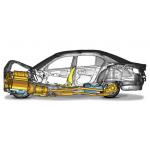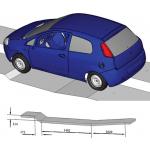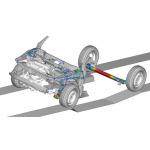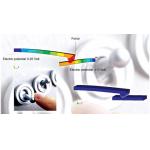Latest News
February 1, 2006
By Louise Elliott
How do structures and fluids interact in a microfluidic pump? How do joined structures and fluids in the same MEMS device react to electromagnetic forces? How can an automotive engineer study both crash-worthiness and passenger safety without creating many different models? These questions and more are being answered by recent advances in finite element analysis (FEA) software.
High-end FEA aims to accomplish a slew of complicated, multidimensional tasks faster and more easily than in the past. Recently released Version 10 from ANSYS, and soon-to-be released Version 6.6 from ABAQUS are cases in point.
Unified FEA
An already large development team at ABAQUS has grown since the company’s acquisition by Dassault Systemes (DS) when DS added its own CAE developers to the staff. The beefed-up ABAQUS team has been working to provide the technology and core design for DS’ Simulia, as well as its FEA program. Ken Short, vice president of strategy and marketing, describes Simulia as an open interface that will enable different classes of developers to work with DS solutions to provide a wide range of engineering and scientific applications. “Simulia is a separate organization,” Short says, “and development is in ]the] very early days.”
|
|
| BMW uses ABAQUS software to conduct a wide range of crashworthiness simulations, such as this full-frontal impact simulation of a BMW 5-series in accordance with USNCAP requirements. |
ABAQUS has simultaneously been developing an analysis approach it calls “Unified FEA.” As part of that effort, the company has been working closely with BMW to develop several applications that will be particularly useful for the automotive industry, Short says. “The idea is to break away from individual silos of products, tools, and user skills. Traditionally, the automotive world has used different simulation tools, resulting in models that can’t be shared, to analyze crash; occupant safety; noise, vibration, and harshness (NVH); and so on. For example, some users want to interface such different products as PAM CRASH and LS-DYNA with Nastran for NVH, and ABAQUS for powertrain analysis. The tools don’t communicate easily.”
Rather than try to force them to communicate, or go on performing separate analyses, ABAQUS seeks to couple its own analysis tools to provide several kinds of simulation in one database.
|
|
| This image shows a finite element model of a Fiat Punto being subjected to a pothole obstacle in an ABAQUS analysis to determine force distribution through the automobile’s drive train. |
“The automotive world wants to get as close as possible to using a single model for all simulation,” says Short. “Toward that goal, the new release has fully capable crashworthiness and occupant safety simulation ability with one model.”
Currently, he adds, the models used for crash and NVH are quite different. Short believes that users would gain great efficiency if they could use a single model and keep up-to-date with the design, while enabling communication between teams. “We can now simulate integrity and durability under abusive loads—including potholes, curb strikes, and cornering with an overloaded vehicle. We’re close to being able to perform full NVH simulation, and want to be able to relieve engineers from having to use many non-associative models.”
As an example of Unified FEA, he points out three separate load cases on a single model of a vehicle hood. The model can be analyzed to determine aerodynamic loading at several different speeds; to learn the strength of the safety catch if the hood pops open at different speeds; and to ensure the hood’s regulatory compliance to rules that it must be flexible enough to protect a pedestrian’s head impacting it.
|
|
| This image shows the Punto’s equivalent stress distribution from a dynamic analysis using the explicit method in ABAQUS. |
The different requirements of manufacturing and CAE in model detail makes it difficult to align finite element models to design models. “The design has to meet manufacturing needs for every detail—while simulation can simplify the model for efficiency,” he says.
Short sums up by saying, “People want more detail with more parts in an assembly; a more detailed model. We’re in the process of evolving to capture more mechanics and get closer to the physical world.”
Coupled Multi-Physics and Huge Problems
In Version 10, ANSYS has improved its fluid-structures interaction (FSI) capabilities with a new multifield solver that, says Mike Wheeler, vice president and general manager for the company’s mechanical business unit, “couples the tools at the time-step level.”
|
|
| This ANSYS image shows the structural, thermal, and electric potential in an analysis of a light switch. |
That capability goes beyond FSI, he says, and can include structural, fluid, and electromechanical analyses at each time step, and the software will iterate the analyses to obtain interaction as the solution converges. “Being able to do this gives customers much greater confidence in the accuracy of their solutions,” Wheeler says. “They can study multiple coupling with simultaneous convergence.” The most common use of this functionality has been in micro-electromechanical (MEMS) devices.
In 2004, ANSYS demonstrated being able to solve problems with more than 100 million degrees of freedom (DOF). Version 10, according to Wheeler, can handle 250 million DOF due to new solvers developed specifically for today’s high-performance computing (HPC) hardware.
“We can now take advantage of new ways to interact with memory on multiple CPUs,” he says. “In the old days, we wrote software for centralized computing on platforms such as SGI. Now, we’re distributing the computation among eight, 10, or 12 boxes, each with between two and four 64-bit CPUs to provide the necessary addressable space.”
Another area in which Version 10 improves on past performance is in probabilistic optimization, which ANSYS now calls variational technology. Wheeler reports that the new version provides faster, more efficient ways to solve Design of Experiments optimization, making it possible, he says, “to offer robust design for all users—because it’s easier, faster, and more accurate.”
On the CFD side, CFX now has a new turbulence model that enables predictive laminar to turbulent flow—a capability of particular importance to turbomachinery and aerospace applications. Chris Reid, vice president and general manager of ANSYS’s fluids business unit, says that this is the first commercially available capability for such prediction.
In addition to specialized wizards and templates for modeling turbomachinery, ANSYS now also provides 15 standard templates that make it possible for companies to capture knowledge within their organizations and streamline their analyses. The templates include structural, steady state thermal, thermal transient, fatigue, shape optimization, electromagnetics, and frequency analyses. “These make it possible for customers to build their own vertical applications. They can edit, copy, and modify the templates for their own specific purposes,” says Wheeler.
Whether it be one model for different automotive simulations, coupled with multiphysics or variational technology for turbulent flow predictions, HPC is assisting high-end FEA in conquering new ground in an increasingly complex world.
Contributing Editor Louise Elliott is a freelance writer based in California. Offer Louise your feedback on this article through e-mail by clicking here. Please reference “FEA Chartered Waters, February 2006” in your message.
Product Information
ABAQUS
Providence, RI
ANSYS
Canonsburg, PA
Bonus Photo Gallery
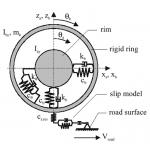
One of the simplest multibody tire models is the 2D rigid ring model developed by Pirelli used commonly in harshness analysis. This model consists of four components including the tire tread-band (infinitely rigid ring), tire sidewalls (modelled as springs and dampers), a contact model (vertical residual stiffness, considering the large deformations in the contact patch, and a slip model) and the rim (modelled as a rigid body). Some extra parameters are calibrated from test. Image courtesy of ABAQUS.
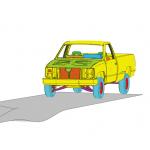
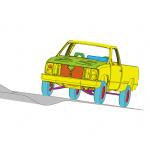
Shown is a substructure analysis of a pick-up truck model in ABAQUS. With unified FEA, durability, crashworthiness, and ride and handling studies can all be performed using the same ABAQUS model. Click images to enlarge.
Subscribe to our FREE magazine, FREE email newsletters or both!
Latest News
About the Author
DE’s editors contribute news and new product announcements to Digital Engineering.
Press releases may be sent to them via [email protected].







